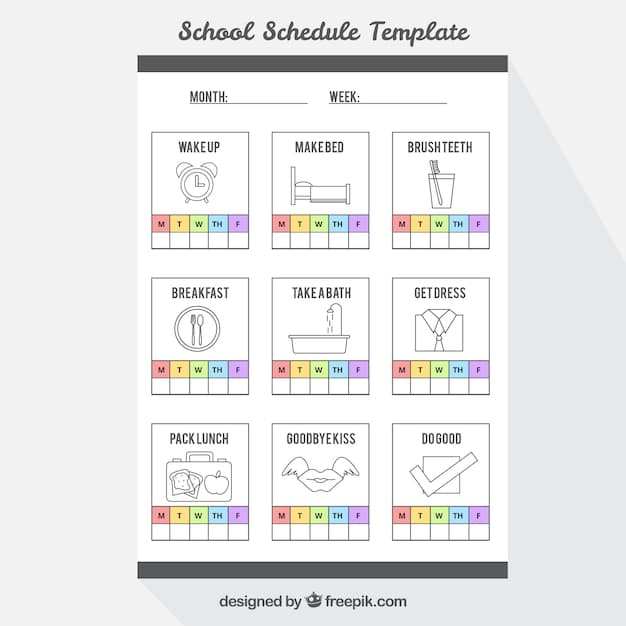Transform Your Habits: Break Bad Patterns & Build Routines in 60 Days

Transforming habits within 60 days involves a structured approach that emphasizes understanding current patterns, setting clear goals, implementing strategic changes, and maintaining consistency to cultivate lasting positive routines for personal growth.
Embarking on a journey to transform your habits: how to break bad patterns and build positive routines in 60 days can feel like a monumental task, yet it is entirely achievable with the right strategy. This comprehensive guide will equip you with the knowledge and actionable steps needed to redefine your daily life, fostering lasting change within a focused two-month period.
Understanding the Science of Habit Formation and Disruption
Before diving into practical steps, it is crucial to grasp the fundamental science behind how habits are formed and, more importantly, how they can be broken. Habits are deeply ingrained neural pathways, efficient shortcuts our brains develop to save energy. They operate on a loop: a cue, a routine, and a reward. Understanding this loop is the first step towards purposeful change.
The Habit Loop: Cue, Routine, Reward
Every habit, good or bad, follows a predictable three-part loop. The cue is the trigger that tells your brain to go into automatic mode and which habit to use. The routine is the behavior itself, whether physical, mental, or emotional. The reward helps your brain decide if this particular loop is worth remembering for the future. Over time, this loop becomes increasingly automatic.
- Cue Recognition: Identifying what triggers your unwanted habits. Is it stress, a specific time of day, or a particular environment?
- Routine Analysis: Deconstructing the exact actions or thoughts that constitute the habit. What do you do, think, or feel during this routine?
- Reward Assessment: Understanding the underlying need or gratification the bad habit provides. What is the emotional or physical payoff?
For instance, if your bad habit is mindless snacking, the cue might be boredom, the routine is eating chips, and the reward is a momentary sense of comfort or distraction. To break this, you need to disrupt one or more parts of this loop.
Neuroplasticity and Habit Change
The good news is that our brains are incredibly adaptable, a concept known as neuroplasticity. This means that while neural pathways for habits are strong, they are not unchangeable. With conscious effort and repetition, new pathways can be formed, and old ones can be weakened. This biological reality underpins the 60-day challenge: consistent action over this period can literally rewire your brain.
Research suggests that while the often-cited 21 days for habit formation is a myth, a period of 60 days provides a more realistic timeframe for new behaviors to become automatic. It allows for overcoming initial resistance, experiencing setbacks, and re-establishing momentum without feeling rushed or demoralized by early failures.
In essence, transforming habits requires a deliberate and informed approach, recognizing that while bad habits offer immediate gratification, their long-term costs often outweigh the temporary benefits. By dissecting the habit loop and leveraging the brain’s capacity for change, you set a sturdy foundation for the changes ahead.
Setting Clear and Achievable Goals for Your 60-Day Transformation
Vague intentions lead to vague results. To successfully transform your habits within 60 days, you must define what success looks like with precision. This means setting goals that are not only ambitious but also realistic, measurable, and aligned with your broader personal growth objectives. The SMART framework is an invaluable tool for this process.
SMART Goal Setting for Habits
Each habit you aim to change or build should be filtered through the SMART criteria:
- Specific: Clearly define what you want to achieve. Instead of “exercise more,” aim for “exercise for 30 minutes, 5 times a week.”
- Measurable: How will you track progress? This could involve logging workouts, noting food intake, or tracking meditation minutes.
- Achievable: Is the goal realistic given your current circumstances and resources? Starting with small, manageable steps increases your chances of success.
- Relevant: Does this habit align with your core values and long-term aspirations? Is it truly important to you?
- Time-bound: Set a clear deadline. The 60-day challenge provides this inherent timeframe. Work backward from this deadline to set smaller, weekly or bi-weekly targets.
Applying the SMART framework to both breaking bad habits and building good ones ensures clarity and directs your efforts effectively. For example, if you want to eliminate procrastination, a SMART goal might be: “For the next 60 days, I will start my most important task within 15 minutes of sitting down at my desk, five days a week, tracking my completion rate.”
Prioritization and Phased Implementation
Attempting to overhaul every aspect of your life at once is a recipe for overwhelm and failure. Instead, identify 1-3 key habits that will have the most significant positive impact if changed. Focus your energy intensely on these first. Once they begin to solidify, you can gradually introduce new goals.
The 60-day period can be divided into phases. The first 30 days might be dedicated to breaking a specific bad habit, like excessive screen time, and establishing a foundational positive one, such as a morning routine. The next 30 days can then focus on reinforcing these new patterns and adding another layer of positive change, perhaps incorporating daily journaling or meal prepping.
This phased approach prevents burnout and allows for focused energy on a few critical shifts, building confidence with each successful step. It’s about strategic wins, not an overwhelming battle on all fronts. Regularly reviewing your progress against your SMART goals will help you stay on track and make necessary adjustments.
Strategic Approaches to Breaking Bad Habits
Breaking a bad habit isn’t merely about stopping a behavior; it’s about replacing an old pattern with a new, healthier one. The vacuum left by removing a bad habit is often filled by something else, so it’s essential to be intentional about what fills that space. This requires a combination of self-awareness, active replacement, and environmental restructuring.
The initial step involves identifying the core triggers and underlying needs that the bad habit fulfills. If you habitually reach for your phone during downtime, is it boredom, a desire for connection, or a need for distraction? Understanding the root cause is paramount to devising an effective strategy. Simply resisting the urge often leads to rebound behaviors or increased stress.
Identify and Disrupt Triggers
Your environment and routine are filled with cues that trigger your bad habits. The most effective way to break a habit is to remove or alter these triggers, especially in the early stages of the 60-day transformation. This might mean:
- Environmental Redesign: If you snack constantly while watching TV, move tempting foods out of sight or out of the house entirely.
- Routine Modification: If you hit snooze repeatedly, move your alarm clock across the room so you have to get out of bed to turn it off.
- Awareness and Delay: When a craving or urge arises, pause. Acknowledge the urge without immediately acting on it. This small delay creates a space for conscious choice.
Consider the “friction” involved. Make it harder to engage in the bad habit. If you waste time on social media, delete the apps from your phone, or only allow yourself access during specific, limited times on a desktop computer.

Replace, Don’t Just Remove
Simply trying to stop a bad habit often fails because the underlying need that the habit fulfilled remains. The key is to consciously substitute the undesirable behavior with a new, positive, or neutral one that provides a similar reward. This is known as “replacement behavior.”
If stress eating is your bad habit, instead of reaching for comfort food, try a 5-minute meditation, take a short walk, or call a friend. The reward might shift from immediate taste pleasure to a sense of calm or connection. The new behavior should be as easily accessible as possible, especially at first, to reduce the cognitive load of making a new choice.
This involves creative problem-solving. For instance, if you bite your nails out of nervous energy, could you try squeezing a stress ball or chewing sugar-free gum instead? The goal is to redirect the energy or satisfy the urge in a healthier way. This strategy is particularly powerful during the 60-day period as it provides a tangible alternative rather than just a void.
Acknowledging setbacks is also crucial. Breaking habits is rarely a linear process. There will be days when you revert to old patterns. The critical part is not to perceive these as failures but as learning opportunities. Analyze what triggered the lapse, adjust your strategy, and recommit. Consistency over 60 days involves resilience and iteration.
Building Positive Routines: A Step-by-Step 60-Day Blueprint
Building positive routines is the flip side of breaking bad habits, and it often involves a similar, but constructively focused, approach. This phase requires discipline, environmental support, and the gradual integration of new behaviors until they become second nature. The 60-day timeframe provides sufficient opportunity for these habits to take root deeply.
Creating routines that stick isn’t about brute-force willpower; it’s about intelligent design. It involves making the desired behavior as easy and appealing as possible, and the undesired behavior as difficult and unappealing as possible. This principle, often called “friction,” is a powerful tool in habit formation.
Starting Small and Stacking Habits
The most common mistake when forming new habits is trying to do too much too soon. Start incredibly small. If you want to start exercising, begin with 5 minutes a day, not an hour. The goal in the early days is consistency, not intensity. Once this tiny habit is ingrained, you can gradually increase its duration or complexity.
Habit stacking is another powerful technique. This involves attaching a new desired habit to an existing, established habit. For example: “After I brush my teeth (existing habit), I will meditate for one minute (new habit).” The existing habit acts as the cue for the new one, making it easier to remember and implement.
- Morning Routines: Stack a new habit (e.g., drinking a glass of water) immediately after an existing one (e.g., getting out of bed).
- Evening Routines: Connect a positive habit (e.g., reading 10 pages) to a regular nightly activity (e.g., getting into bed).
- Workday Routines: Link a new productive habit (e.g., reviewing your to-do list) to a recurring work task (e.g., opening your laptop).
This method leverages the automaticity of existing routines to embed new ones, reducing the need for constant conscious effort and increasing the likelihood of long-term adherence within your 60-day sprint.
Designing Your Environment for Success
Your environment plays a massive role in shaping your habits. Make your desired habits obvious, attractive, easy, and satisfying. This is often referred to as “architecting your environment.”
If you want to eat healthier, keep healthy snacks visible and unhealthy ones hidden or out of the house. If you want to read more, keep a book on your bedside table. If you want to exercise, lay out your workout clothes the night before. This eliminates mental friction and makes the desired action the path of least resistance.
Think about how you can physically set up your space to encourage the behaviors you want to cultivate. The less effort required to initiate a good habit, the more likely you are to do it, especially in the initial, fragile stages of the 60-day transformation. Conversely, increase the “friction” for bad habits. Make them harder to do.
Consistency is key. Even on days when motivation wanes, adhering to the small, easy version of your habit reinforces the neural pathways. The 60-day period allows for this repetition, gradually transitioning the behaviors from conscious effort to automatic routine.
Tracking Progress, Staying Motivated, and Overcoming Setbacks
The 60-day journey to habit transformation is rarely linear. There will be days of high motivation and days when you feel like giving up. Effective tracking, strategic motivation techniques, and a resilient approach to setbacks are essential for navigating this period successfully.
The Power of Tracking and Visualization
What gets measured gets managed. Tracking your habits provides concrete evidence of your progress, which is incredibly motivating. Simple habit trackers (digital apps, a calendar with X’s, or a journal) can offer visual proof of your consistency.
Seeing a chain of successful days creates a powerful incentive not to break the chain. This tangible feedback reinforces the reward pathway in your brain, making the desirable behavior more likely to be repeated. For instance, if you’re building a reading habit, marking off each day you read in a calendar gives you a visual win.
Beyond tracking, visualizing your success can be a strong motivator. Picture yourself having already achieved your goals – how do you feel? What does your transformed life look like? This mental rehearsal can strengthen your commitment and activate the neural pathways associated with success.

Intrinsic vs. Extrinsic Motivation
While external rewards can be useful in the early stages of habit formation (e.g., treating yourself after a week of consistent workouts), sustained habit change is driven by intrinsic motivation. Connect your new habits to a deeper sense of purpose or identity.
Instead of “I have to exercise,” think “I am a healthy person who prioritizes my well-being.” Shifting your self-perception to align with your desired habits makes the behavior feel less like a chore and more like an expression of who you are becoming. This identity-based approach fosters long-term adherence beyond the 60 days.
Public accountability can also be a powerful extrinsic motivator. Sharing your goals with a trusted friend, family member, or online community can provide an extra layer of commitment and support. Knowing someone is checking in on your progress can be a strong deterrent against giving up.
Embracing and Learning from Setbacks
A setback is not a failure; it’s a data point. Everyone experiences them. The difference between those who succeed and those who don’t lies in their response to these inevitable moments. Instead of self-criticism, adopt a mindset of curious analysis.
When you miss a day, ask: What was the trigger? What circumstances led to this lapse? How can I prevent it next time? This reflective process turns a potential derailment into a valuable learning opportunity. Don’t let one missed day turn into two, or two into a week. Get back on track immediately. The “never miss twice” rule is a powerful mantra for resilience.
Forgive yourself, adjust your strategy if necessary, and recommit with renewed vigor. The 60-day period is long enough to experience both successes and setbacks, providing ample opportunity to practice this resilience and solidify your new habits.
Sustaining Your Transformative Changes Beyond 60 Days
The 60-day period is a powerful sprint, a focused window for establishing new patterns. However, true transformation isn’t just about reaching the 60-day mark; it’s about making these new habits a permanent part of your life. The strategies for sustaining change are often simpler than the initial effort of formation, focusing on integration, adaptation, and continued self-awareness.
Once a habit becomes more automatic, the cognitive energy required to perform it significantly decreases. This is where the long-term benefits truly manifest, as your new routines free up mental bandwidth for other pursuits. The goal is to move from conscious effort to subconscious mastery.
Integration and Systemization
After 60 days, many of your new habits should feel significantly more ingrained. Your focus now shifts from actively “doing the habit” to “being the person who does the habit.” Integrate these routines seamlessly into your daily life rather than having them feel like separate tasks.
Look for ways to systemize your new behaviors. If you’ve developed a morning exercise routine, consider pre-packing your gym bag the night before, pre-setting your coffee maker, or ensuring your favorite motivating music is ready. The less you have to think about or prepare, the more likely you are to continue.
Automating certain aspects can also help. For instance, if your habit is saving money, set up automatic transfers to your savings account. If it’s healthy eating, automate grocery deliveries with healthy options. These small structural changes reduce the reliance on willpower and increase the likelihood of continuity.
Flexibility and Refinement
Life is unpredictable, and rigid adherence to routines can lead to burnout or abandonment when circumstances change. While consistency is key, cultivating a degree of flexibility is equally important for long-term sustainability. Be willing to adapt your habits when life throws a curveball.
If your morning workout routine is disrupted by an early appointment, perhaps a lunchtime walk or a shorter evening session can serve as a suitable, temporary alternative. The aim is to maintain the essence of the habit, even if the execution varies. This flexibility prevents feeling defeated when the ideal scenario isn’t possible.
Regularly review and refine your habits. Are they still serving you? Can they be optimized? Over time, you might find that a 30-minute meditation is more effective for you than a 10-minute one, or that a different type of exercise better suits your evolving fitness goals. Continuous refinement keeps your habits dynamic and relevant to your ongoing personal growth journey.
Engaging in self-compassion is also vital here. There will be times when you regress or fall off track, even months after the 60-day sprint. Instead of harsh self-criticism, approach these moments with understanding and recommit. The journey of personal growth and habit optimization is a lifelong one, characterized by continuous learning and adaptation.
Embracing the Journey: The Transformative Power of Habit Change
The 60-day commitment to transforming your habits is more than just a period of behavior modification; it’s an immersive journey into self-discovery and intentional living. By systematically addressing bad patterns and diligently cultivating positive routines, you embark on a path that redefines not just what you do, but who you are becoming.
This period of concentrated effort lays down a robust foundation for enduring personal growth. It teaches you resilience, reinforces your capacity for discipline, and builds self-trust as you witness your ability to create meaningful change in your life. The ripple effects of even one transformed habit can be profound, impacting your health, relationships, productivity, and overall well-being. It is a testament to the cumulative power of small, consistent actions.
Beyond the Days: A Lifelong Practice
While 60 days marks a significant milestone, habit transformation is not a destination but a continuous process of refinement and adaptation. As life evolves, so too will your needs and aspirations. The skills you cultivate during this focused period – self-awareness, strategic planning, consistency, and resilience in the face of setbacks – are invaluable for navigating future challenges and opportunities for growth.
- Continuous Learning: Stay curious about new habit-forming techniques and psychological insights.
- Self-Compassion: Embrace imperfections and lapses as part of the human experience; avoid harsh self-judgment.
- Celebration and Reflection: Acknowledge your progress, no matter how small, and periodically reflect on how your habits serve your overarching life vision.
The true power of habit transformation extends far beyond the individual behaviors themselves. It lies in the profound shift in identity that occurs when you consistently act in alignment with the person you aspire to be. You move from saying “I want to be a morning person” to embodying “I am a morning person.”
This internal shift is the most enduring reward. The discipline of the 60-day challenge acts as a catalyst, empowering you to author a more purposeful and fulfilling life, one intentional habit at a time.
| Key Point | Brief Description |
|---|---|
| 🎯 Goal Setting | Define habits with SMART goals for clarity and measurable progress. |
| 🔁 Habit Loop | Understand the cue-routine-reward cycle to effectively break or build habits. |
| 🌱 Build & Replace | Form new routines with habit stacking; replace bad habits with positive alternatives. |
| 📈 Track & Adapt | Monitor progress and embrace flexibility to sustain changes beyond 60 days. |
Frequently Asked Questions About Habit Transformation
While the exact time varied for habit formation, 60 days provides a robust timeframe, exceeding the often-cited but misleading “21 days.” It allows for initial habit establishment, overcoming setbacks, and reinforcing new neural pathways for behaviors to become more automatic and feel natural. This duration offers ample opportunity for consistent practice.
Missing a day is common and not a failure. The key is to avoid the “all or nothing” mindset. Acknowledge the lapse without self-judgment, analyze what triggered it, and immediately get back on track the next opportunity you have. The “never miss twice” rule is effective; consistency over time is more important than perfection.
It is generally recommended to focus on 1-3 habits at a time. Attempting too many changes simultaneously can lead to overwhelm and failure. Prioritize the habits that will have the most significant positive impact on your life, master them, and then gradually introduce new ones after the existing changes are well-established.
Your environment is crucial. It acts as a powerful source of cues and can either support or hinder your habit goals. Design your surroundings to make good habits easy and obvious (e.g., leaving workout clothes out) and bad habits difficult and invisible (e.g., removing tempting snacks). Environmental design reduces reliance on willpower.
Habit stacking is pairing a new desired habit with an existing, well-established one. For example, “After I finish my morning coffee, I will meditate for five minutes.” The existing habit (coffee) acts as a reliable cue for the new habit (meditation), making it easier to remember and integrate into your daily routine without extra effort.
Conclusion
The prospect of transforming deeply ingrained habits in just 60 days might seem daunting at first, but with a strategic approach, unwavering consistency, and a profound understanding of habit psychology, it is an entirely achievable and immensely rewarding endeavor. By meticulously dissecting the habit loop, setting clear and measurable goals, and employing tactics like environmental design and habit stacking, you lay the groundwork for profound, lasting change. Remember, the journey is not about eliminating imperfections but about cultivating intentionality and building resilience. This two-month sprint provides a powerful catalyst, empowering you to reshape your daily actions and, in turn, redefine your future self, solidifying behaviors that truly serve your highest aspirations long beyond the initial 60 days.





